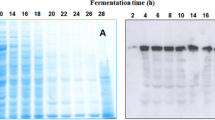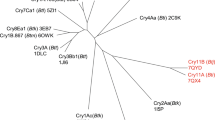Abstract
THE isolation of the protein crystals of Bacillus thuringiensis, which are toxic to the larvae of certain species of insects, has been described previously1,2, and involves phase separation in which an aqueous phase consisting of a suspension of spores and crystals is emulsified with a variable volume of an organic solvent such as trifluorotrichloroethane. When the two phases are mixed, most of the spores and some of the crystals are removed from the aqueous phase into the organic phase and crystals are left in the aqueous phase. An ideal method would recover 100 per cent of crystals completely free from spores. This has not yet been achieved; usually the greater the degree of crystal purity required, the lower is the yield of crystals.
This is a preview of subscription content, access via your institution
Access options
Subscribe to this journal
Receive 51 print issues and online access
$199.00 per year
only $3.90 per issue
Buy this article
- Purchase on Springer Link
- Instant access to full article PDF
Prices may be subject to local taxes which are calculated during checkout
Similar content being viewed by others
References
Angus, T. A., J. Insect Path., 1, 97 (1959).
Bateson, J. B., Nature, 205, 622 (1965).
Angus, T. A., Canad. J. Microbiol., 2, 416 (1956).
Doak, B. W., and Lamanna, C., J. Bact., 55, 373 (1948).
Author information
Authors and Affiliations
Rights and permissions
About this article
Cite this article
PENDLETON, I., MORRISON, R. Separation of the Spores and Crystals of Bacillus thuringiensis. Nature 212, 728–729 (1966). https://doi.org/10.1038/212728a0
Issue Date:
DOI: https://doi.org/10.1038/212728a0
This article is cited by
-
Bacillus thuringiensis promotes systemic immunity in tomato, controlling pests and pathogens and promoting yield
Food Security (2024)
-
The distribution pattern of DNA and protoxin in Bacillus thuringiensis as revealed by laser confocal microscopy analysis
Applied Microbiology and Biotechnology (2015)
-
Identification of cry-Type Genes on 20-kb DNA Associated with Cry1 Crystal Proteins from Bacillus thuringiensis
Current Microbiology (2005)
-
Quantitative determination of ?-endotoxin contents in spray-dried preparations ofBacillus thuringiensis strain GC-91
World Journal of Microbiology & Biotechnology (1992)
Comments
By submitting a comment you agree to abide by our Terms and Community Guidelines. If you find something abusive or that does not comply with our terms or guidelines please flag it as inappropriate.



